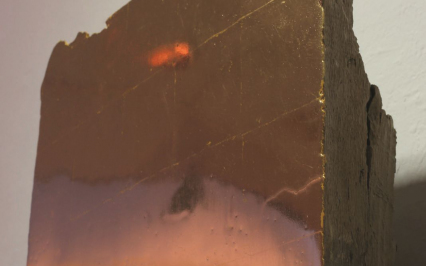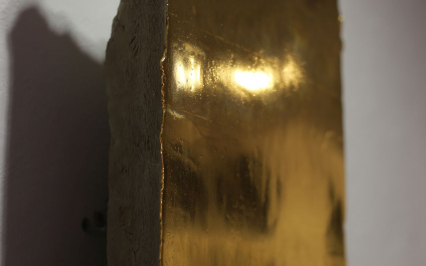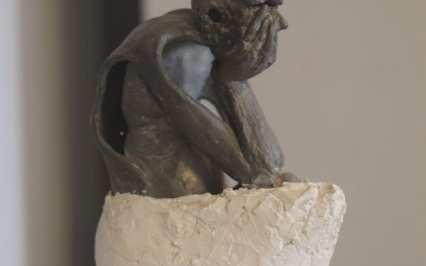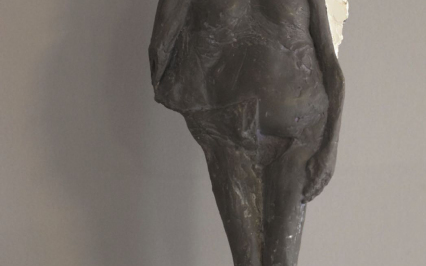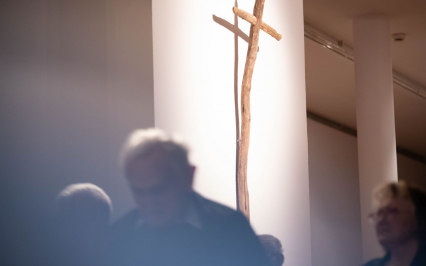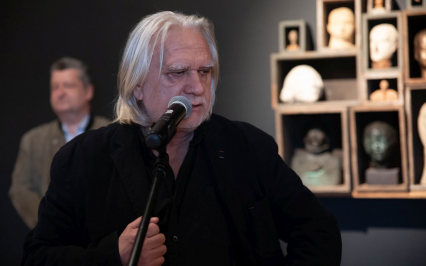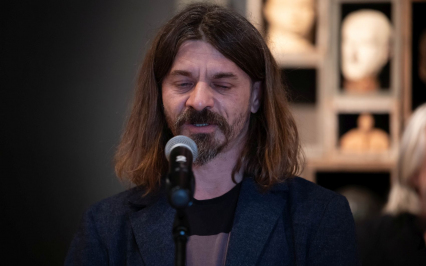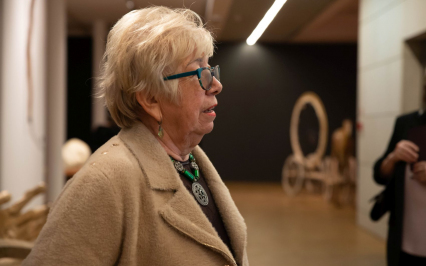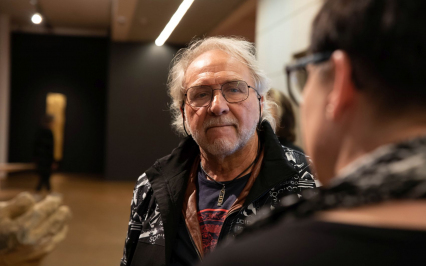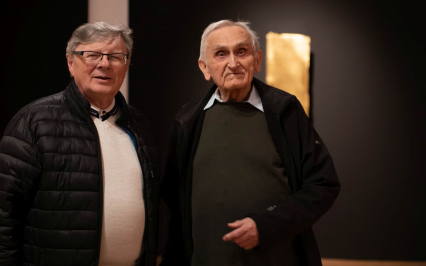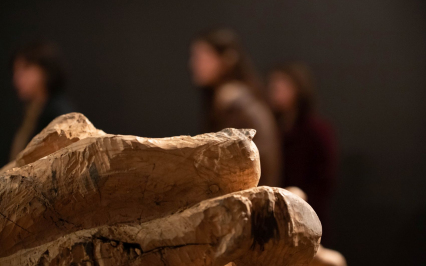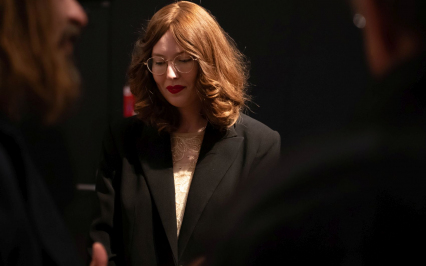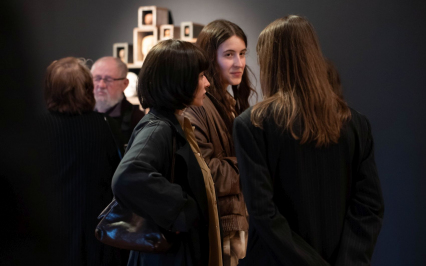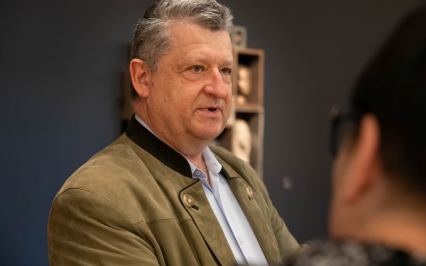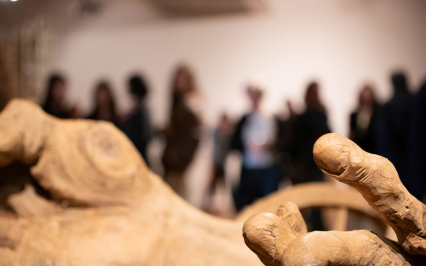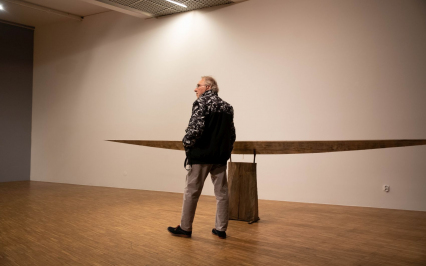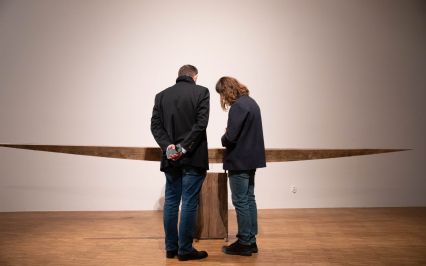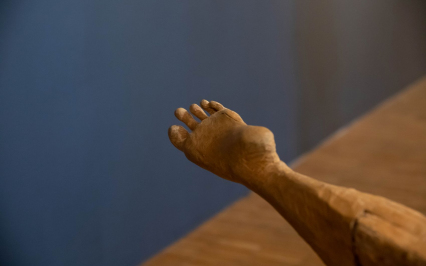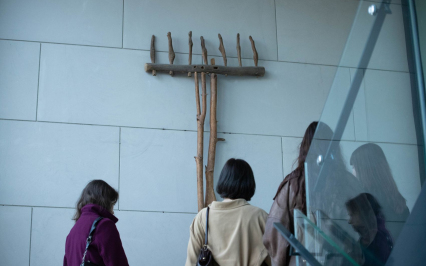GRZEGORZ WITEK - SCULPTURE
21 April - 11 June 2023
BWA SOKÓŁ Gallery of Contemporary Art
vernissage:
21 April 2023, hour 18:00
Additional information:
May 6-14 the exhibition "Grzegorz Witek - SCULPTURE" partially inaccessible - no possibility to visit the first floor of the exhibition . On the stated date, tickets for the exhibition - 2nd floor, at a discounted price - PLN 3.
We invite you to see an exhibition of sculpture by Gregory Witek.
Jerzy Brukwicki
MAN — NATURE — PASSAGE OF TIME
The works of Grzegorz Witek – a sculptor and author of spatial objects and installations – is a peculiar story of a man and his relations with nature, of order and harmony of the world, of life and rituals of everyday existence, of lasting and passing away. The artist, professor at Warsaw Academy of Fine Arts, takes interest and focuses his search around the issues that are vital for people. These include issues that require objective and right solutions, related to the existence and the meaning of our life, the good and the evil, freedom and enslavement. Open to the challenges of the contemporary world, the artist refers in his own, peculiar way, to human experience, emotions and achievements. He is constantly inspired by man, who incessantly faces adversities, entangled in everyday reality, and nature – mysterious, metaphysical, spontaneous and defiant…
Contemporary man lives surrounded by people, animals and plants, as well as thousands of objects, machines and buildings. He is entangled in various events and actions; cornered by hubbub, chaos and information overload. He loses the feeling of value, gets rid of sensitivity. The deepening humanistic and ecological crisis prevents people from building fair, sensible and friendly living space. Grzegorz Witek’s sculptures and objects evoke overwhelming reflections on the current state of the world and play a clever game with tradition, encourage us to be prudent and cautious, to deal with the existing spiritual and material conditions, and register the passage of time.
In the self-commentary to his exhibition titled “Self-Reflection” in Warsaw’s Visual Artist House (January 2016), the artist wrote: For a long time I have been wondering who I am, what I do and why I do it. Being a sculptor, sometimes an artist, I have so many ideas and themes in my head. I wish to give some of them spatial – artistic form. However, when I enter my atelier and try to sketch something down on a piece of paper, I am attacked by doubts – does it make sense? Who needs it? I could sculpt portraits, human figures, representational compositions, but at present I am not satisfied with it, as it does not answer the questions that bother me. My works are often abstract, they are various shapes – objects. And here I ask myself… why am I doing this and for whom? Some piece of clay or a bit of stone. Nevertheless, I sit down and think about this fragment of nature, nature that has beauty and that provides answers to everything that bothers me. My works are materialized reflections on nature, passing time, spirituality, they provide some sort of answers to the questions troubling me. However, I often find these answers far from satisfactory, as they are answers only to my imagination. But what else can I do?
MAN — NATURE — PASSAGE OF TIME
The works of Grzegorz Witek – a sculptor and author of spatial objects and installations – is a peculiar story of a man and his relations with nature, of order and harmony of the world, of life and rituals of everyday existence, of lasting and passing away. The artist, professor at Warsaw Academy of Fine Arts, takes interest and focuses his search around the issues that are vital for people. These include issues that require objective and right solutions, related to the existence and the meaning of our life, the good and the evil, freedom and enslavement. Open to the challenges of the contemporary world, the artist refers in his own, peculiar way, to human experience, emotions and achievements. He is constantly inspired by man, who incessantly faces adversities, entangled in everyday reality, and nature – mysterious, metaphysical, spontaneous and defiant…
Contemporary man lives surrounded by people, animals and plants, as well as thousands of objects, machines and buildings. He is entangled in various events and actions; cornered by hubbub, chaos and information overload. He loses the feeling of value, gets rid of sensitivity. The deepening humanistic and ecological crisis prevents people from building fair, sensible and friendly living space. Grzegorz Witek’s sculptures and objects evoke overwhelming reflections on the current state of the world and play a clever game with tradition, encourage us to be prudent and cautious, to deal with the existing spiritual and material conditions, and register the passage of time.
In the self-commentary to his exhibition titled “Self-Reflection” in Warsaw’s Visual Artist House (January 2016), the artist wrote: For a long time I have been wondering who I am, what I do and why I do it. Being a sculptor, sometimes an artist, I have so many ideas and themes in my head. I wish to give some of them spatial – artistic form. However, when I enter my atelier and try to sketch something down on a piece of paper, I am attacked by doubts – does it make sense? Who needs it? I could sculpt portraits, human figures, representational compositions, but at present I am not satisfied with it, as it does not answer the questions that bother me. My works are often abstract, they are various shapes – objects. And here I ask myself… why am I doing this and for whom? Some piece of clay or a bit of stone. Nevertheless, I sit down and think about this fragment of nature, nature that has beauty and that provides answers to everything that bothers me. My works are materialized reflections on nature, passing time, spirituality, they provide some sort of answers to the questions troubling me. However, I often find these answers far from satisfactory, as they are answers only to my imagination. But what else can I do?
The early stage of the sculptor’s works offers a summary of his childhood and adolescence experiences, a dive into his memories of the smell and color of the ground, the surface and the inside of trees, the transparency of water, the transience of air. Drawing from the tradition of Podkarpacie folklore, he created metaphorical images of farming tools and vehicles (“Wheelbarrow”, “Plow”, “Rake”, “Winner”, “Pendulum”), which show people’s attitude to everyday life and their struggle with complications and impediments. They talk about life that had its quiet rhythm closely following the laws of nature; they evoke the memory of forgotten past, they make us realize that it is nature, presently dominated and ruthlessly exploited by man, that offers us the only chance to survive.
The artist is fascinated by human figure and devotes a lot of time to portrait sculpture. People have a few faces: smiling and sad, cheerful and gloomy, pensive and sensible, showing satisfaction of disappointment. Nearly throughout his whole career the artist has developed his cycle titled “Heads”. In small scale works, deprived of excessive details, it is not the reality of the image of a portrayed person that matters, but the presentation of a person’s expression and sensuality, passion and expectations, anger and helplessness, symbolic description of a person’s physical and spiritual presence, revelation of one’s selfconfidence or shyness, being lost in the world labyrinth. Irregular heads and little heads, with blurred features, appearing in various representations, present the truth about man and express human experience.
In 2002–2003 the sculptor made a very special and personal cycle titled “Dialogue”, devoted to Mr. Kazimierz, a hearing – and visuallyimpaired model in one of the sculpture ateliers at Warsaw Academy of Fine Arts. He wrote about this project: The sculptures from this cycle reflect what I find most bothering and interesting – the relations between me and a person posing, between the external world and the internal world. I picked lead and gypsum, as these materials interact by matching, chilling and initiating dialogue. The cycle was interestingly commented on by Lena Wicherkiewicz, an art critic, who wrote in her text titled “On the sculpting activity of Grzegorz Witek”: An attempt at coming closer to the internal world of a model through observing his body, changing poses and gestures, individual distortions caused by routine movements, adopted masks and armor, constitutes a very interesting expression on him. This is some sort of a conversation with a man through sculpting means: through reflecting the shape, through naturalism and expression, through applied materials – lead and gypsum. The materials, symbolically, seem to reflect the dual nature of man – spiritual and carnal, and maybe also joy – sadness, as well as internal doubts, conflicts, some unmanageable difficulties. Small sizes of these figures evoke human frailty, frailty the sculptor respects and pays attention to.
The artist is fascinated by human figure and devotes a lot of time to portrait sculpture. People have a few faces: smiling and sad, cheerful and gloomy, pensive and sensible, showing satisfaction of disappointment. Nearly throughout his whole career the artist has developed his cycle titled “Heads”. In small scale works, deprived of excessive details, it is not the reality of the image of a portrayed person that matters, but the presentation of a person’s expression and sensuality, passion and expectations, anger and helplessness, symbolic description of a person’s physical and spiritual presence, revelation of one’s selfconfidence or shyness, being lost in the world labyrinth. Irregular heads and little heads, with blurred features, appearing in various representations, present the truth about man and express human experience.
In 2002–2003 the sculptor made a very special and personal cycle titled “Dialogue”, devoted to Mr. Kazimierz, a hearing – and visuallyimpaired model in one of the sculpture ateliers at Warsaw Academy of Fine Arts. He wrote about this project: The sculptures from this cycle reflect what I find most bothering and interesting – the relations between me and a person posing, between the external world and the internal world. I picked lead and gypsum, as these materials interact by matching, chilling and initiating dialogue. The cycle was interestingly commented on by Lena Wicherkiewicz, an art critic, who wrote in her text titled “On the sculpting activity of Grzegorz Witek”: An attempt at coming closer to the internal world of a model through observing his body, changing poses and gestures, individual distortions caused by routine movements, adopted masks and armor, constitutes a very interesting expression on him. This is some sort of a conversation with a man through sculpting means: through reflecting the shape, through naturalism and expression, through applied materials – lead and gypsum. The materials, symbolically, seem to reflect the dual nature of man – spiritual and carnal, and maybe also joy – sadness, as well as internal doubts, conflicts, some unmanageable difficulties. Small sizes of these figures evoke human frailty, frailty the sculptor respects and pays attention to.
Grzegorz Witek finds inspiration in contacts between man and an object, the location of such contacts in time and space, in specific situations when something “between” them is born. The artist does not remain indifferent to signs of injustice, anarchy, violence or rape. He sympathizes with those who have been hurt, humiliated and frustrated, he cheers them up and shares his optimism with them. Through his actions he encourages people to look around carefully, he reminds them of the need of freedom and social independence, he appeals to them to take responsibility for the future of not only their nearest and dearest, but the whole world. He talks about something that is timeless
He talks about something that is timeless and universal, but he also comments on current issues. He deliberately distances himself from the climate of temporary, politicized art. His statements on political situation are balanced and prudent. It is a pity that there are not many sculptures and installations devoted to this topic (“Cage”, In the Name…”). They are distinguished by incredible appeal. A particularly intriguing work titled “Facts” presents an ill-treated man, submerged in a sea of cruelty and blood, locked in a transparent gun bullet.
The artists presents the subject of human reason and folly, conditions and possibilities of steering one’s behavior, mechanisms of taking decisions, the issue of memory and identity, in a series of intuitive works that emanate penetrating silence: “Homo Sapiens”, “Thought”, “Memory”, “Conscience”, “Stained-Glass Window”, “Icon”, “Perfection”. Full of pensiveness, concentration and metaphysical impulses, they create the space encouraging us to analyze our personality, they prove that human beings are dependent on a number of factors and situations over which we have no influence. They emphasize human spontaneity, helplessness and absurdity. They pose questions concerning the meaning of life, ethical and moral systems, principles of freedom and independence. They all refer to the significance and role of our mind, human intellectual predispositions, our scope of reasoning and creation, effects of our activity.
Grzegorz Witak astonishes us with the application of new ways of shaping sculptures and objects, their content and emotional scale, variety of materials from which they are made. He uses wooden logs and boughs, field stones, clay, sand, gypsum, marble, lead, bronze, glass, water, silicon, live plants. He uses their peculiar structure and color. In his sculpting practice he eagerly uses various organic substances, as they witnessed the history of Earth and they carry information on our planet, documenting the passage of time.Jerzy Brukwicki
He talks about something that is timeless and universal, but he also comments on current issues. He deliberately distances himself from the climate of temporary, politicized art. His statements on political situation are balanced and prudent. It is a pity that there are not many sculptures and installations devoted to this topic (“Cage”, In the Name…”). They are distinguished by incredible appeal. A particularly intriguing work titled “Facts” presents an ill-treated man, submerged in a sea of cruelty and blood, locked in a transparent gun bullet.
The artists presents the subject of human reason and folly, conditions and possibilities of steering one’s behavior, mechanisms of taking decisions, the issue of memory and identity, in a series of intuitive works that emanate penetrating silence: “Homo Sapiens”, “Thought”, “Memory”, “Conscience”, “Stained-Glass Window”, “Icon”, “Perfection”. Full of pensiveness, concentration and metaphysical impulses, they create the space encouraging us to analyze our personality, they prove that human beings are dependent on a number of factors and situations over which we have no influence. They emphasize human spontaneity, helplessness and absurdity. They pose questions concerning the meaning of life, ethical and moral systems, principles of freedom and independence. They all refer to the significance and role of our mind, human intellectual predispositions, our scope of reasoning and creation, effects of our activity.
Grzegorz Witak astonishes us with the application of new ways of shaping sculptures and objects, their content and emotional scale, variety of materials from which they are made. He uses wooden logs and boughs, field stones, clay, sand, gypsum, marble, lead, bronze, glass, water, silicon, live plants. He uses their peculiar structure and color. In his sculpting practice he eagerly uses various organic substances, as they witnessed the history of Earth and they carry information on our planet, documenting the passage of time.Jerzy Brukwicki
His large format, contemplation spatial realizations make a huge impression (“Humbleness”, “Altars – For Water”, “Rambler”), presenting coexistence of nature and people. The artist is alarmed by natural disasters and violent climate changes. The objects, made from combinations of wood, dried, cracked soil and living plants, make it easier for viewers to understand the essence of nature and to learn dramatic effects of the clash between human activity and the power of wind, the element of water and fire. The wide dissonance between people and their civilization environment and the natural substance of the world leads to irreversible transformations of the climate and ecological cataclysms. The impressive objects warn us against the imminent catastrophes and degenerations, total destruction; they encourage to seek global solutions. Their monumental and harsh form contrasts with fragility of materials used in them. Apart from them the artist creates small, subtle works, which reveal the strong need of coexistence of people, animals, trees and grass, various cultures and religions. They constitute sculpture morality plays on carefree deeds of man against the world of nature, his irresponsible actions leading to biological annihilation and destruction of the world; they provoke many questions on the limits of human intervention in the structures and existence of nature. The sculptor’s works arouse the need to seek, at all cost, ecological harmony, to save forests, fields, meadows, rivers, lakes and seas, water and air.
The artists has frequently referred to Christian tradition and icon writing in his works, taking up topics and threads connected with spirituality, morality and dignity. The heartbreaking “Sorrowful”, expressive “John the Baptist”, universal “Seeds” and “Act of Creation – the New Me” manifest the sense of his spiritual considerations and experiences.
The artists has frequently referred to Christian tradition and icon writing in his works, taking up topics and threads connected with spirituality, morality and dignity. The heartbreaking “Sorrowful”, expressive “John the Baptist”, universal “Seeds” and “Act of Creation – the New Me” manifest the sense of his spiritual considerations and experiences.
Grzegorz Witek returned to his “Heads” cycle after years. In 2020 he created an installation titled “And What Next?” (a monumental head from unbaked clay, placed on wooden, massive stretcher), which is an insightful metaphor of human life, a symbol of passing time and of dying. It forces viewers to seriously evaluate their intentions and achievements and to assess their attempts and deeds.
One of his latest monumental works is a sculpture titled “Horizon”, made two years ago during the Contemporary Sculpture Symposium in Polish Sculpture Center in Orońsko. My “Horizon” constitutes an attempt at accomplishing my goal, at the layers of human creativity and nature which is an important signpost in everyday life – the author confesses. This is the outcome of a process of material transformation (metal and wood), where influenced by temperature, with participation of fire and human creation, melted metal penetrates the inside of a hollowed trunk and crystallizes into a new, unknown shape. This action left a permanent trace of the transformation of material, form and thought.
Grzegorz Witek – a sensitive and uncompromising creator, with a specific ability to image and interpret human existence, its sense and value, enchanted with the beauty of nature, mutual relations between non-material and material – he helps us understand and comment on the existing order in the world, its essence and logic. His nearly 30 years of artistic career have brought varied output which evokes strong emotions and sensations. He belongs to a broadly understood field of dreams of freedom and independence, a field of disagreement with the deconstruction and disintegration of the world, thoughtless destruction of nature. He speaks of the time with which nearly every aspect of human existence, each manifestation of nature is connected, namely imminence of the passage of time. He bravely, and sometimes with bravado, crosses traditional boundaries of sculpture rules. He is an experimenting artist. He discovers new truths about man and notices new forms of human civic awareness and sensitivity, revealing thus new space for art. He shares with us everything that is important and essential for him.
One of his latest monumental works is a sculpture titled “Horizon”, made two years ago during the Contemporary Sculpture Symposium in Polish Sculpture Center in Orońsko. My “Horizon” constitutes an attempt at accomplishing my goal, at the layers of human creativity and nature which is an important signpost in everyday life – the author confesses. This is the outcome of a process of material transformation (metal and wood), where influenced by temperature, with participation of fire and human creation, melted metal penetrates the inside of a hollowed trunk and crystallizes into a new, unknown shape. This action left a permanent trace of the transformation of material, form and thought.
Grzegorz Witek – a sensitive and uncompromising creator, with a specific ability to image and interpret human existence, its sense and value, enchanted with the beauty of nature, mutual relations between non-material and material – he helps us understand and comment on the existing order in the world, its essence and logic. His nearly 30 years of artistic career have brought varied output which evokes strong emotions and sensations. He belongs to a broadly understood field of dreams of freedom and independence, a field of disagreement with the deconstruction and disintegration of the world, thoughtless destruction of nature. He speaks of the time with which nearly every aspect of human existence, each manifestation of nature is connected, namely imminence of the passage of time. He bravely, and sometimes with bravado, crosses traditional boundaries of sculpture rules. He is an experimenting artist. He discovers new truths about man and notices new forms of human civic awareness and sensitivity, revealing thus new space for art. He shares with us everything that is important and essential for him.








